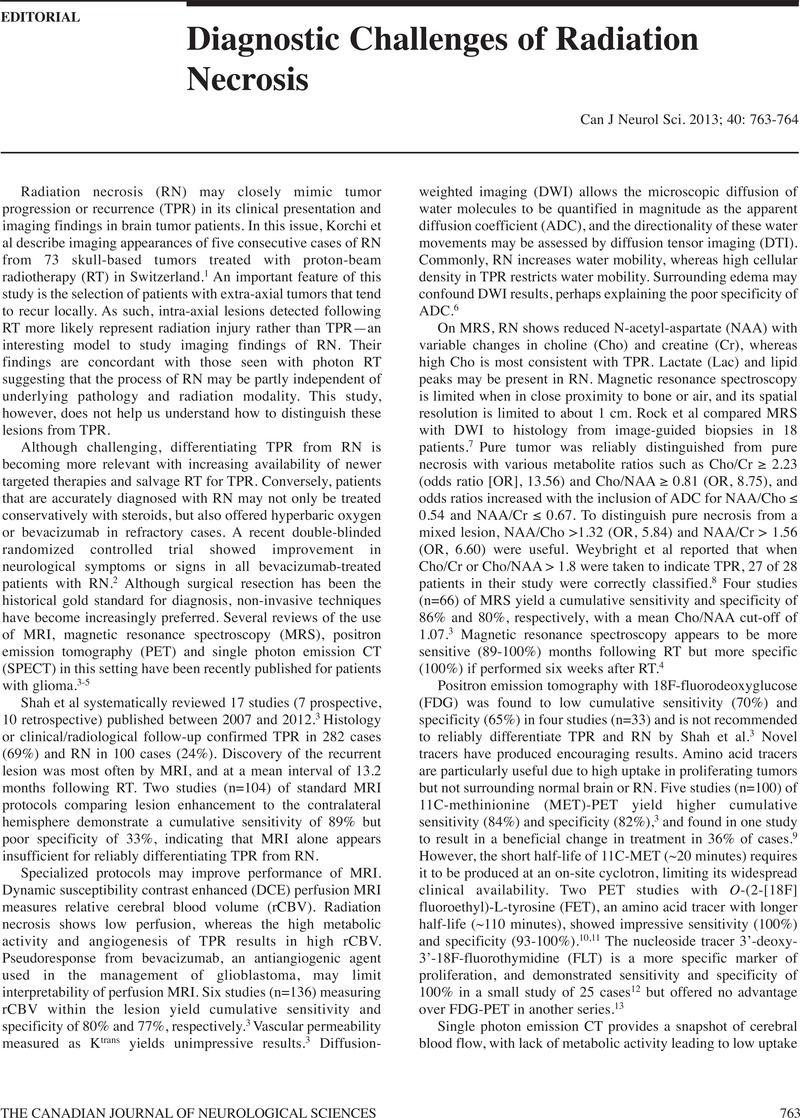No CrossRef data available.
Article contents
Diagnostic Challenges of Radiation Necrosis
Published online by Cambridge University Press: 23 September 2014
Abstract
An abstract is not available for this content so a preview has been provided. As you have access to this content, a full PDF is available via the ‘Save PDF’ action button.

- Type
- Editorial
- Information
- Copyright
- Copyright © The Canadian Journal of Neurological 2013
References
1.
Korchi, AM, Garibotto, V, Lovblad, K-O, Haller, S, Weber, DC. Radiologic patterns of necrosis after proton therapy of skull base tumors. Can J Neurol Sci. 2013;40(6):800–6.CrossRefGoogle ScholarPubMed
2.
Levin, VA, Bidaut, L, Hou, P, et al. Randomized double-blind placebo-controlled trial of bevacizumab therapy for radiation necrosis of the central nervous system. Int J Radiat Oncol Biol Phys. 2011;79:1487–95.Google Scholar
3.
Shah, AH, Snelling, B, Bregy, A, et al. Discriminating radiation necrosis from tumor progression in gliomas: a systemic review what is the best imaging modality?
J Neurooncol. 2013;112:141–52.Google Scholar
4.
Caroline, I, Rosenthal, MA. Imaging modalities in high-grade gliomas: pseudoprogression, recurrence, or necrosis?
J Clin Neurosci. 2011;19:633–7.Google Scholar
5.
Rahmathulla, G, Marko, NF, Weil, RJ. Cerebral radiation necrosis: a review of the pathobiology, diagnosis and management considerations. J Clin Neurosci. 2013;20:485–502.Google Scholar
6.
Cha, J, Kim, ST, Kim, HJ, et al. Analysis of the layering pattern of the apparent diffusion coefficient (ADC) for differentiation of radiation necrosis from tumour progression. Eur Radiol. 2013;23:879–86.Google Scholar
7.
Rock, JP, Scarpace, L, Hearshen, D, et al. Associations among magnetic resonance spectroscopy, apparent diffusion coefficients, and image-guided histopathology with special attention to radiation necrosis. Neurosurgery. 2004;54:1111–17.Google Scholar
8.
Weybright, P, Sundgren, PC, Maly, P, et al. Differentiation between brain tumor recurrence and radiation injury using MR spectroscopy. AJR Am J Roentgenol. 2005;185:1471–6.Google Scholar
9.
Yamane, T, Sakamoto, S, Senda, M. Clinical impact of (11)C-methionine PET on expected management of patients with brain neoplasm. Eur J Nucl Med Mol Imaging. 2010;37:685–90.CrossRefGoogle ScholarPubMed
10.
Rachinger, W, Goetz, C, Pöpperl, G, et al. Positron emission tomography with O-(2-[18F]fluoroethyl)-L-tyrosine versus magnetic resonance imaging in the diagnosis of recurrent gliomas. Neurosurgery. 2005;57:505–11.Google Scholar
11.
Pöpperl, G
Götz, C
Rachinger, W
Gildehaus, FJ
Tonn, JC
Tatsch, K. Value of O-(2-[18F]fluoroethyl)-L-tyrosine PET for the diagnosis of recurrent glioma. Eur J Nucl Med Mol Imaging. 2004;31:1464–70.Google Scholar
12.
Chen, W, Cloughesy, T, Kamdar, N, et al. Imaging proliferation in brain tumors with 18F-FLT PET: comparison with 18F-FDG. J Nucl Med. 2005;46:945–52.Google Scholar
13.
Enslow, MS, Zollinger, LV, Morton, KA, et al. Comparison of F-18 fluorodeoxyglucose and F-18 fluorothymidine positron emission tomography in differentiating radiation necrosis from recurrent glioma. Clin Nucl Med. 2012;37:854–61.CrossRefGoogle Scholar
14.
Gömez-Río, M
Rodríguez-Fernández, A, Ramos-Font, C, López-Ramírez, E, Llamas-Elvira, JM. Diagnostic accuracy of 201Thallium-SPECT and 18F-FDG-PET in the clinical assessment of glioma recurrence. Eur J Nucl Med Mol Imaging. 2008;35:966–75.Google Scholar




